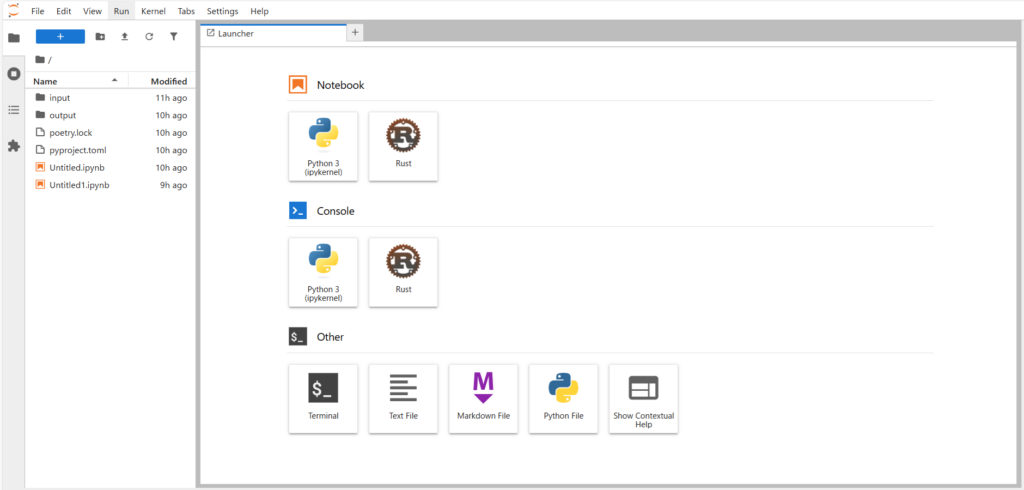对象OS:ubuntu24.04 (AWS的EC2 m6a.large)
web服务器:nginx
jupyter作为subpath安装,而不是subdomain安装。
不是通过docker来安装,而是作为python的一个应用来安装。
1.python虚拟环境的安装
我个人喜欢poetry来管理。
curl -sSL https://install.python-poetry.org | python3 -
export PATH="/home/ubuntu/.local/bin:$PATH"下面是Poetry的初期设定:
sudo mkdir -p /data/.cache/pypoetry
sudo mkdir -p /data/.local/share/pypoetry
sudo chown -R ubuntu:ubuntu /data/.cache
sudo chown -R ubuntu:ubuntu /data/.local定义Poetry的数据存储位置:
vi .profile
POETRY_DATA_DIR=/data/.local/share/pypoetry
vi .bashrc
POETRY_DATA_DIR=/data/.local/share/pypoetry
source .profile
source .bashrc以下是poetry虚拟环境的设定(重点):
poetry config --list
poetry config virtualenvs.in-project true
poetry config cache-dir /data/.cache/pypoetry2.jupyter的安装
poetry安装好了后,就可以创建一个虚拟环境(env)来执行jupyterlab了。
sudo mkdir /data/juplab
sudo chown -R ubuntu:ubuntu /data/juplab
cd /data/juplab
poetry init
以上是虚拟环境的初期化,基本上默认值。
下面重点来了,安装shell插件。
poetry self add poetry-plugin-shell
不安装插件的时候,得用下面的命令进入虚拟环境:
eval $(poetry env activate)
安装了插件后,就只要下面的一句话:
poetry shell
重点:shell的插件安装必须的。要不然进入到poetry的虚拟环境比较费劲。
安装了shell的插件,可以用poetry shell进入虚拟环境。
进入虚拟环境后,添加jupyterlab的package,然后启动
cd /data/juplab
poetry init
poetry shell
poetry add jupyterlab
先生成密码——不用担心记不住,密码存放在/home/ubuntu/.jupyter/jupyter_lab.json里
jupyter lab password
3.配置jupyter
重点:token无效化,password认证有效化,外部访问有效化,以及作为subpath的设定
jupyter --config-dir
jupyter lab --generate-config
vi /home/ubuntu/.jupyter/jupyter_lab_config.py
c.ServerApp.ip = '0.0.0.0'
c.ServerApp.port = 8030
c.IdentityProvider.token = ''
c.PasswordIdentityProvider.hashed_password = u'xxx'
c.PasswordIdentityProvider.allow_password_change = False
c.ServerApp.open_browser = False
c.ServerApp.allow_remote_access = True
c.ServerApp.allow_origin = '*'
c.ExtensionApp.open_browser = False
c.ServerApp.base_url = '/subpath4lab'jupyter –config-dir:确认配置文件的路径
jupyter lab –generate-config:生成默认的配置文件
4.jupyter作为ubuntu的service设定
jupyter作为service启动配置如下:
sudo vi /etc/systemd/system/jupyter.service
[Unit]
Desctiption = Jupyter Lab
After = syslog.target
[Service]
Type = simple
WorkingDirectory = /data/privlab
Restart = always
ExecStart = /home/ubuntu/.local/bin/poetry run jupyter lab
User = ubuntu
Group = ubuntu
[Install]
WantedBy = multi-user.target然后daemon重新加载,服务自启动有效化:
sudo systemctl daemon-reload
sudo systemctl start jupyter.service
sudo systemctl status jupyter.service
sudo systemctl enable jupyter.service这个时候可以通过浏览器访问了:
http://server-ip:8030/subpath4lab
5.nginx代理jupyter的设定
通常我们会把jupyter挂载在自己网站下的,web服务器是nginx的时候,配置比较简单,如下:
location /subpath4lab {
proxy_pass http://127.0.0.1:8030;
proxy_http_version 1.1;
proxy_set_header Upgrade $http_upgrade;
proxy_set_header Connection "upgrade";
proxy_set_header Host $host;
proxy_set_header X-Real-IP $remote_addr;
proxy_set_header X-Forwarded-For $proxy_add_x_forwarded_for;
proxy_redirect off;
proxy_buffering off;
proxy_read_timeout 86400;
auth_basic "Restricted";
auth_basic_user_file /etc/nginx/.securepswd;
}主要难点是websocket的配置,这个在nginx里,一个Upgrade和Connection “update”搞定!
为了防止他人利用,还增加了basic auth认证,实际上还要追加fail2ban之类的。详细看fail2ban的设定篇。
设置完之后,就可以通过域名访问了。
https://domain/subpath4lab/lab


